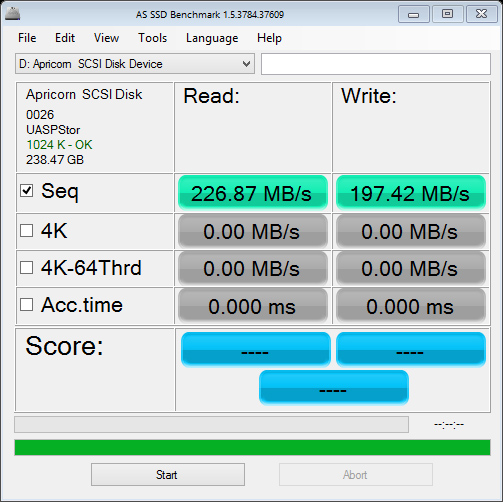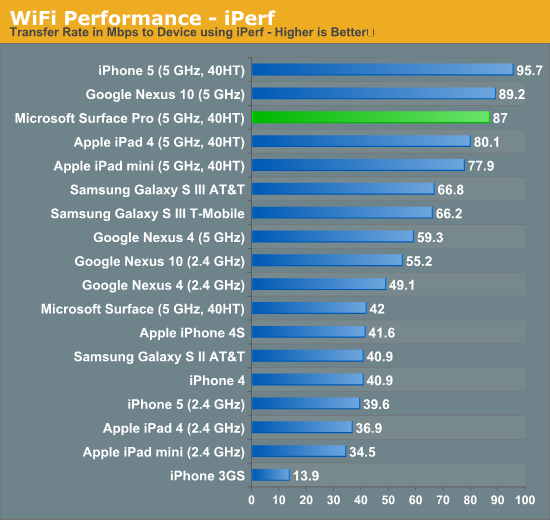Microsoft Surface Pro Review
by Anand Lal Shimpi on February 5, 2013 9:00 PM ESTFans and Thermals
While Surface RT was passively cooled, Surface Pro features two integrated fans to cool the 17W Core i5-3317U. For most light use cases, those two fans will remain spun down and you can’t hear them. Do any sort of serious multitasking or start using Surface Pro as a real PC instead of a tablet and you’ll quickly hear them spin up. Fan noise is audible but not annoying - it’s very similar to the sound you’d hear out of any ultraportable with a couple of tiny fans spinning up.
In landscape mode with the Type Cover attached, Surface Pro draws in cool air from the sides and exhausts it out of the top of the device. Rotate the device into portrait mode and the fans will switch directions, drawing in cool air from the long edge and exhausting it out of the short edges. The fan direction switch is triggered in tandem with display rotation, so as soon as you see your display rotate you’ll hear the fans change direction.
The two fans do a good job keeping the CPU cool (I saw typical CPU core temperatures between 50C - 60C), but Surface Pro does get warm. I measured a max surface temperature of 41.8C while running 3DMark 11. That’s towards the top of the unit, around where the Core i5 CPU is located. On the edges I measured a max surface temperature of 36.5C. There’s no getting around the fact that Surface Pro gets warm, noticeably more so than the 4th generation iPad. It never gets uncomfortably hot however.

Despite being a tablet, the Core i5-3317U had no issues hitting its max turbo frequency of 2.6GHz. I even saw 2.75GHz for a very short period of time (remember, Intel’s Turbo Boost can exceed max TDP until the silicon gets up to temperature).
Storage and USB 3.0
Surface Pro ships with a micro SDXC slot along the edge of the device. Courtesy of Intel’s HM77 chipset, you also get a full blown 6Gbps SSD and a single USB 3.0 port - both significant upgrades over Surface RT. In my 128GB review sample, Surface Pro features a Micron C400 SSD. Microsoft is sourcing from multiple SSD vendors and claims to be shipping with optimized firmware, but I don’t know what other vendors are in the mix. Update: It looks like the C400 SSD is an mSATA drive, likely similar to the one we reviewed here a while back.

To put this in perspective, the C400 is in the same class of storage device that’s used in Apple’s MacBook Air. Although some ARM based SoCs feature SATA interfaces, pretty much all of them are paired with eMMC based NAND storage solutions that are horribly slow. The fastest sequential transfer rates I’ve managed on the 4th generation iPad are typically on the 20 - 30MB/s range, whereas the C400 in the Surface Pro is good for over 400MB/s in reads and just under 200MB/s in writes.

There’s been a lot of debate over the amount of free space available on Windows RT/8 tablets fresh out of the box. My 128GB review sample was partitioned down to 110GB with roughly 8GB used for the recovery partition. Of that 110GB, 89.5GB was free space that remained. I don’t really view this as false advertising by Microsoft (both Macs and PCs have been sold like this for decades), but you do need to know what you’re getting into here. Given the already high price of these systems and the relatively small price differential between a 64GB Surface Pro and a 128GB model, I’d recommend going for the latter. Microsoft claims something like 29GB of free space remains on the 64GB model - enough for some apps and data, but keep in mind like all solid state storage you don’t want to completely fill up your drive either (this is also true for ARM based tablets like the iPad).
USB 3.0 is equally as impressive on Surface Pro. Using a simple USB 3.0 to SATA adapter I could easily read and write at around 200MB/s. Compare this to the ~20MB/s you get on most ARM based tablets and it’s obvious that this Surface deserves its Pro moniker.

Ultimately Surface Pro’s storage subsystem is a big part of what separates it from the current crop of ARM based tablets. While it’s possible to run productivity workloads on many tablets these days, there’s truly very little that separates what you can do on Surface Pro with what what you can do on a conventional PC.
WiFi Performance
Similar to Surface RT, Surface Pro uses a 2x2 802.11n WiFi controller from Marvell. I believe this is likely the same Marvell Avastar 88W8797 WiFi solution, but connected over USB instead of SDIO.
WiFi performance is appreciably better than on Surface RT, connected to a 5GHz 802.11n network I was able to pull a maximum of 87Mbps compared to 42Mbps on Surface RT. This is competitive with what I’ve seen on other high-end tablets based on ARM architectures, although lower than what I’ve gotten out of a MacBook Air.

WiFi range is subjectively really good on Surface Pro and a lot better than most ARM based tablets I’ve played with. I ran an iperf test on an iPad 4 and Surface Pro around 100 feet away from an AP through several walls and saw roughly an order of magnitude better performance out of the Surface Pro (8 - 10Mbps vs. 0.95 Mbps).
While peak WiFi performance out of Surface Pro is similar to a high-end tablet, worst case performance is more like a good notebook. Overall I’m pleased with the wireless stack on Surface Pro.










228 Comments
View All Comments
amrs - Wednesday, February 6, 2013 - link
I'm also wondering why the SSD benchmark showed only throughput? No 4k random access or access time tests?jack.fxx - Wednesday, February 6, 2013 - link
Surface Pro has 5 times greater performance than competing ARM tablets with half battery life.nangryo - Wednesday, February 6, 2013 - link
Considering cellular cell draws more power. I think you should separate the result of the wifi test and cellular test. Because makes the Galaxy Tab chart below Surface whilst it is using cellular connection makes it a bit inaccuratemaximumGPU - Wednesday, February 6, 2013 - link
can someone block this douche who's been polluting a lot of AT's threads?milli - Wednesday, February 6, 2013 - link
After reading this review, I have to conclude that Intel is ahead of ARM in regards to power efficiency on every front. Before this review, it was obvious that Clover Trail is competitive to the current ARM offerings on power usage and speed. And it's soon to be upgraded with the Silvermont core and 22nm.But Intel's i5 ULV seems to be better at performance/watt too. >5x faster while offering half the battery life. Even on a TDP level compared to Exynos 5 it's twice the power (8W vs 17W) while offering >4x the performance on the cpu front and at least 2-3x the performance on the GPU.
With Haswell and 22nm Atoms coming, it's seems ARM's stand against Intel is going to be more short lived than many believed.
LetsGo - Wednesday, February 6, 2013 - link
In your dreams, the Nexus 10 drives a much higher resolution then the surface pro and is the first iteration of A15's. ARM chips will undercut Intel's and deliver just as good performance because the real heavy work is done in the GPU.Watch Intel's share price drop in the coming years.
Netscorer - Wednesday, February 6, 2013 - link
Your conclusion is wrong. Clover Trail may have matched ARM power consumption but is still below the par on performance and is completely pathetic in GPU performance. To add insult to injury, it is priced substantially higher then ARM chips, so good luck seeing it in many mobile devices.Ivy Bridge is the top dog in performance but is still far from being optimized for power consumption. Haswell will (we all hope) change that but again, at much much higher prices then ARM design. When you have a CPU alone cost $250, forget about building budget tablets around it.
kyuu - Thursday, February 7, 2013 - link
What? Clover Trail is faster than any ARM SoC except for A15 -- and A15s use more power than Clover Trail.powerarmour - Wednesday, February 6, 2013 - link
$899 for a 64GB SSD with only 23GB free space... Give me a break...amdwilliam1985 - Wednesday, February 6, 2013 - link
$499 for 16GB with only 13GB free space... what the heck...Consumers should spend 2x$499 to get 26GB free space, haha this way they can beat surface pro in terms of non-removable space, lol.
On the other hand, feel free to insert SD card, USB flash, USB 3.0 external, NAS and etc...
What does the $499 offer you? They'll accuse you of stealing mp3, mp4, mp5 or whatever else they can accuse you of stealing. Yesterday they're telling you that you're holding it wrong, today they're calling you using the device the wrong way, I guess tomorrow they'll just call you stupid plain and clear so it's dummy proof ;)